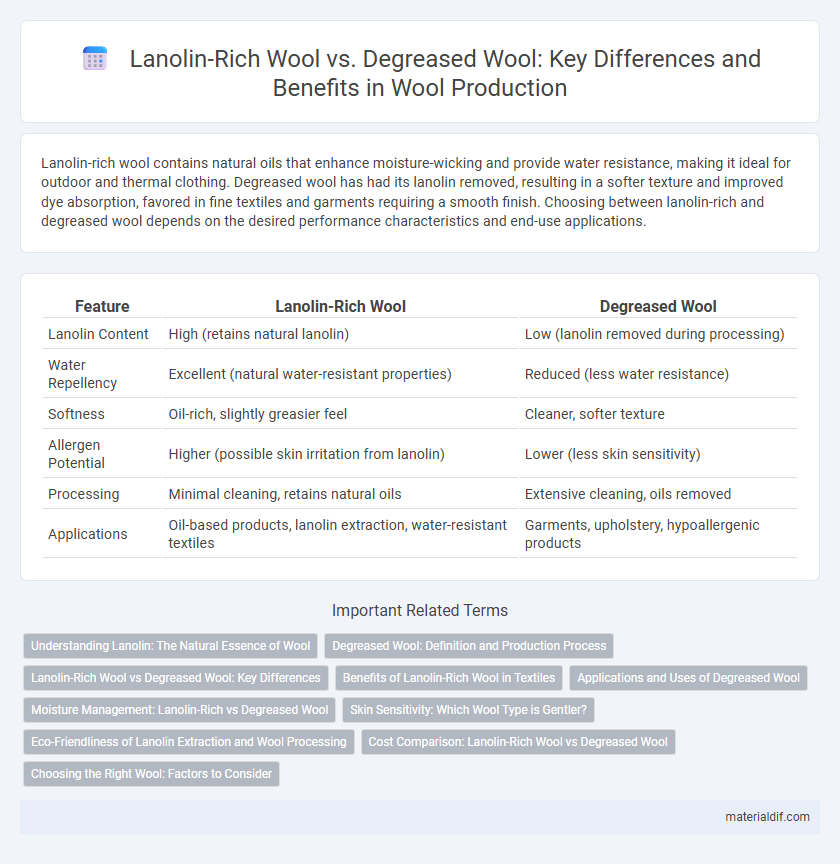Lanolin-rich wool contains natural oils that enhance moisture-wicking and provide water resistance, making it ideal for outdoor and thermal clothing. Degreased wool has had its lanolin removed, resulting in a softer texture and improved dye absorption, favored in fine textiles and garments requiring a smooth finish. Choosing between lanolin-rich and degreased wool depends on the desired performance characteristics and end-use applications.
Table of Comparison
| Feature | Lanolin-Rich Wool | Degreased Wool |
|---|---|---|
| Lanolin Content | High (retains natural lanolin) | Low (lanolin removed during processing) |
| Water Repellency | Excellent (natural water-resistant properties) | Reduced (less water resistance) |
| Softness | Oil-rich, slightly greasier feel | Cleaner, softer texture |
| Allergen Potential | Higher (possible skin irritation from lanolin) | Lower (less skin sensitivity) |
| Processing | Minimal cleaning, retains natural oils | Extensive cleaning, oils removed |
| Applications | Oil-based products, lanolin extraction, water-resistant textiles | Garments, upholstery, hypoallergenic products |
Understanding Lanolin: The Natural Essence of Wool
Lanolin-rich wool contains a natural waxy substance secreted by the sebaceous glands of sheep, acting as a protective barrier that retains moisture and enhances fiber softness. Degreased wool undergoes a scouring process to remove lanolin, resulting in cleaner but drier fibers that lack the natural conditioning and water-repellent properties of untreated wool. Understanding the role of lanolin is essential for optimizing wool's performance in textile applications, as its presence influences durability, elasticity, and comfort.
Degreased Wool: Definition and Production Process
Degreased wool refers to raw wool that has undergone a scouring process to remove lanolin, dirt, and impurities, resulting in a cleaner and more refined fiber suitable for textile manufacturing. The production process involves washing the wool in a series of hot water baths with detergents and solvents to effectively extract grease and contaminants while preserving fiber integrity. This treatment enhances the wool's dyeing properties, softness, and overall quality for use in apparel and industrial applications.
Lanolin-Rich Wool vs Degreased Wool: Key Differences
Lanolin-rich wool retains its natural lanolin, providing superior water resistance, softness, and antibacterial properties compared to degreased wool, which has been chemically treated to remove lanolin and other impurities. This treatment process in degreased wool enhances its suitability for dyeing and processing in textiles but reduces its natural moisture-wicking and protective benefits. Understanding these key differences helps in selecting the appropriate wool type for specific applications, balancing performance and processing needs.
Benefits of Lanolin-Rich Wool in Textiles
Lanolin-rich wool retains natural oils that enhance fabric softness, moisture-wicking, and antibacterial properties, making textiles more comfortable and hygienic. The presence of lanolin improves wool's water repellency, reducing the need for chemical treatments and increasing fabric durability. Consumers benefit from lanolin-rich textiles due to their natural hypoallergenic qualities and better thermal insulation compared to degreased wool.
Applications and Uses of Degreased Wool
Degreased wool is extensively used in textile manufacturing due to its clean fiber surface, which improves dye absorption and fabric quality. It serves as a prime raw material in high-end garments, upholstery, and industrial felts where purity and texture are critical. Unlike lanolin-rich wool, degreased wool is preferred for applications requiring hypoallergenic properties and consistent processing outcomes.
Moisture Management: Lanolin-Rich vs Degreased Wool
Lanolin-rich wool retains its natural wax coating, enhancing moisture management by repelling water while allowing breathability, which keeps the skin dry and comfortable. Degreased wool, with lanolin removed, absorbs more moisture and takes longer to dry, potentially leading to a clammy feel in humid conditions. The presence of lanolin significantly improves wool's ability to balance moisture, making lanolin-rich wool preferable for activewear and outdoor garments.
Skin Sensitivity: Which Wool Type is Gentler?
Lanolin-rich wool contains natural oils that provide a moisturizing barrier, making it gentler and less irritating for sensitive skin compared to degreased wool. Degreased wool undergoes a chemical process to remove lanolin, which can strip the fiber of its natural softness and increase the likelihood of skin dryness or irritation. For individuals with skin sensitivity, lanolin-rich wool offers enhanced comfort and reduced risk of allergic reactions.
Eco-Friendliness of Lanolin Extraction and Wool Processing
Lanolin-rich wool retains natural oils that reduce the need for harsh chemical treatments in wool processing, promoting a more sustainable and eco-friendly approach. Degreased wool undergoes extensive washing and chemical extraction, increasing water usage and pollution risks. Eco-friendly lanolin extraction methods prioritize solvent-free or biodegradable solvents, minimizing environmental impact while preserving wool quality.
Cost Comparison: Lanolin-Rich Wool vs Degreased Wool
Lanolin-rich wool typically incurs higher costs due to the extra processing required to preserve the natural lanolin content, which enhances water resistance and softness. Degreased wool, having undergone extensive scouring to remove lanolin, offers a lower price point because of reduced processing complexity and is favored for industrial and textile applications needing clean fiber. The price difference is also influenced by the intended end-use, with lanolin-rich wool often commanding a premium in markets prioritizing natural fiber qualities and skin-friendly properties.
Choosing the Right Wool: Factors to Consider
Lanolin-rich wool retains natural oils that provide superior moisture resistance and softness, making it ideal for insulated clothing and water-repellent applications. Degreased wool, stripped of lanolin, offers enhanced dye absorption and is preferred for delicate textile manufacturing and hypoallergenic products. Selecting between lanolin-rich and degreased wool depends on the desired end-use, balancing factors like moisture management, fabric texture, and allergenic sensitivity.
Lanolin-rich wool vs Degreased wool Infographic

 materialdif.com
materialdif.com